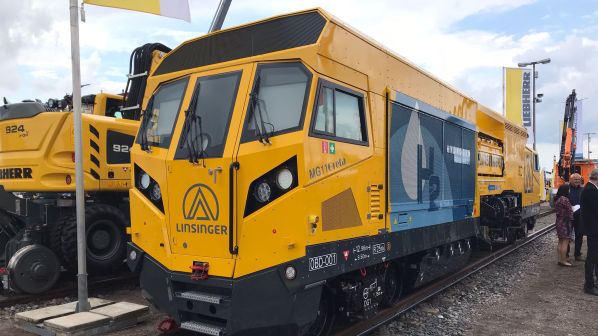IRJ at IAF 2022: Linsinger has unveiled the MG11 Hydrogen, the world’s first hydrogen-powered track milling machine, at this year’s event ahead of the start of trials with two European metros later this summer.
The four-axle machine is around 30m long and weighs 38.1 tonnes. Onboard, hydrogen storage tanks supply a 230kW fuel cell, which converts hydrogen into electricity via electrolysis. The electricity is used to charge 240kW batteries installed at the rear of the machine, which power the train’s traction system. The batteries are also available to provide back-up power to enable the train to move in the event of an emergency.
Linsinger says the machine has “almost the same” power output as an equivalent diesel unit. The MG11 H2 has a top speed of 60km/h and in addition to electricity, the only byproduct of electrolysis is water, which is released from the left hand side of the unit, directly beneath the fuel cell. Linsinger says that combined with its no dust, no sparks milling process, the train is an attractive proposition for underground metro networks to address growing concerns about diesel emissions and excessive dust as a byproduct of grinding.
Indeed, the supplier says it is ready to begin trials with two operators at the end of next month before the machine is shown at InnoTrans in Berlin in September. Linsinger CEO, Mr Günter Holleis, would not reveal the precise identity of the operators, but as well as Europe he says networks in Japan are “very interested” in the potential offered by hydrogen for infrastructure maintenance machines.
The project required a complete reconfiguration of the MG11’s interior layout compared with the standard diesel unit. Hybrid diesel-hydrogen options are also envisaged according to technical director, Mr Juergen Binder, who says Linsinger wants to ensure flexibility in its offer. It has worked alongside TUV Sud throughout the development process to ensure the machine’s design complied with necessary regulations.
Linsinger has also worked with an external supplier on a mobile refuelling concept while Binder says Linsinger is ready to work with network owners also to install a fixed hydrogen refuelling facility at depots, a proposition he says is becoming increasingly viable. Refuelling takes around 30 minutes to complete, which Linsinger says is more attractive than an equivalent battery unit that may take seven to eight hours to recharge.
The MG11 is designed for use in tight profile metro networks and Holleis says it developed the hydrogen drive for this unit specifically so that it is scalable to its larger fleet of mainline machines. The company says it expects to show a second prototype, the MG21 H2, at InnoTrans in 2024.

